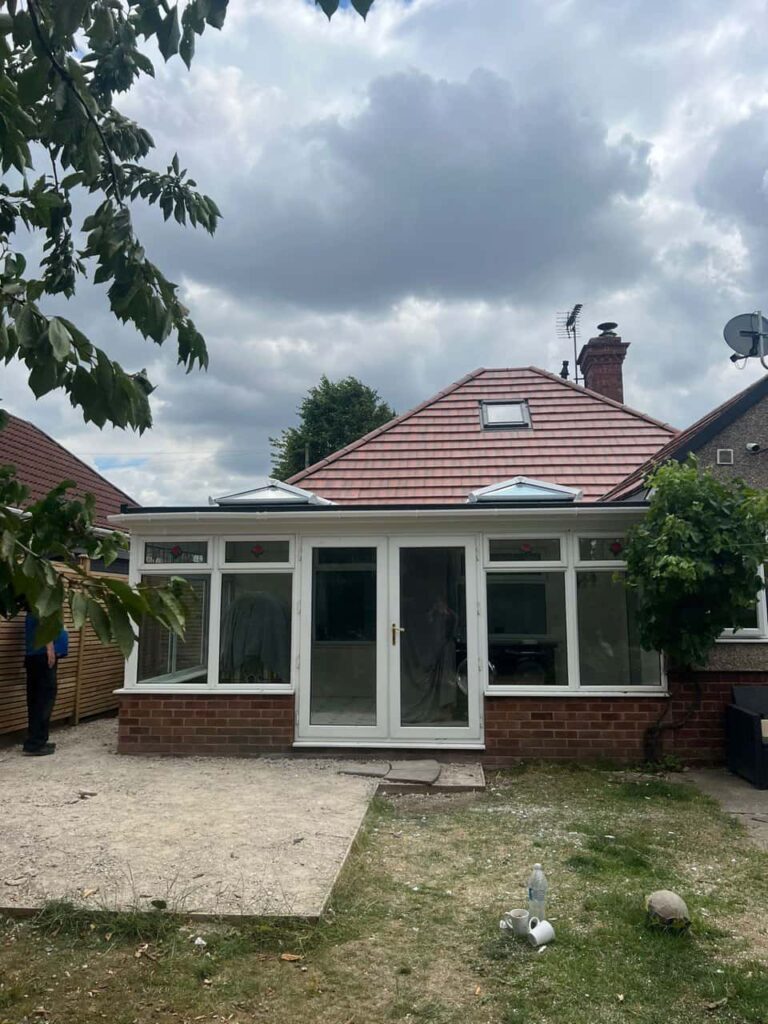A sagging gable roof is a serious concern for homeowners and property managers alike. It can lead to costly repairs, potential safety hazards, and significant damage if left unaddressed. Understanding the causes of roof sagging and how to fix it is essential for maintaining the integrity of your home.
At Ripley Roofing Repairs, we specialise in roof repairs and maintenance in Ripley, Derbyshire. In this blog post, we will explore the most common reasons behind gable roof sagging and provide guidance on what to do if you encounter this issue.
1. Understanding Gable Roofs
Gable roofs are characterised by their triangular shape, with two sloping sides that meet at the peak of the roof. These roofs are popular in residential homes due to their aesthetic appeal, simplicity, and the ability to allow for additional attic space.
However, despite their many advantages, gable roofs can be susceptible to sagging when certain conditions arise. Identifying the cause of the sag is crucial for determining the appropriate course of action.
2. Common Causes of Gable Roof Sagging
Several factors can contribute to the sagging of a gable roof, and addressing these issues early can prevent further damage and costly repairs.
1. Excessive Weight on the Roof
One of the primary reasons a gable roof sags is the weight placed on it. Whether it’s due to snow, ice, or accumulated debris, too much weight can strain the roof structure and cause it to dip. This is especially problematic for older roofs or those with already weakened structural supports.
- Snow and ice build-up: Snow and ice can accumulate on the roof, putting excessive pressure on the rafters and trusses. Over time, this weight can cause the roof to sag, especially if the roof was not designed to handle such loads.
- Debris: Fallen branches, leaves, and other debris can add extra weight to the roof, causing it to sag in certain areas.
2. Weakened or Damaged Roof Support Beams
The support beams, also known as rafters, are essential to maintaining the structural integrity of the roof. If these beams are weakened or damaged, they may not be able to support the roof properly, leading to sagging. There are several reasons why roof support beams might weaken:
- Wood rot: If the timber rafters are exposed to moisture over time, they can begin to rot, reducing their ability to bear weight.
- Pest infestations: Pests like termites can damage the wood beams, causing them to weaken and eventually sag under the load of the roof.
- Poor initial construction: In some cases, sagging may occur because the roof was not built with proper support. Poorly designed or improperly installed support beams can lead to long-term sagging problems.
3. Poor Roof Design
A poorly designed roof can be a major contributor to sagging. If the roof structure was not properly engineered to support the weight of the roof or the elements it must endure, it may gradually begin to sag over time.
- Insufficient trusses: Trusses are used to support the roof and distribute its weight evenly. If the trusses are too few, too weak, or improperly placed, they may not be able to handle the load, leading to sagging.
- Inadequate pitch: The slope of the roof, or pitch, plays an important role in the overall structural integrity. If the roof is too flat or not pitched at the correct angle, it may increase the risk of sagging over time.
4. Foundation Issues
If your home’s foundation is shifting or settling, it can cause misalignment in the roof structure, including sagging. Foundation problems can occur due to soil movement, water damage, or improper foundation construction.
- Shifting foundations: When the foundation of a home shifts, it can lead to structural issues, including a sagging roof. This can be particularly noticeable in homes with older foundations that may have deteriorated over time.
- Water damage to foundations: If water is seeping into the foundation, it can weaken the structure and lead to misalignment, causing the roof to sag.
5. Age of the Roof
As a roof ages, the materials it’s made from naturally deteriorate, making it more vulnerable to sagging. Over time, the rafters and other structural components may weaken due to wear and tear, leading to sagging.
- Deteriorating roofing materials: Older roofs may have worn out shingles, cracked tiles, or weakened support beams that are no longer able to handle the weight of the roof and the external elements.
- Long-term exposure to weather: Prolonged exposure to rain, wind, and UV rays can take a toll on the roofing materials, causing them to become brittle and weak.
3. Signs Your Gable Roof Is Sagging
It’s important to be able to identify the early signs of a sagging roof to address the issue before it worsens. Keep an eye out for the following indicators:
- Visible sagging in the roofline: If you notice that the roofline is dipping or uneven, this is a clear sign that your gable roof is sagging.
- Cracked or buckling ceilings: Internal cracks in the ceilings, particularly in the areas closest to the roof supports, may indicate structural issues in the roof.
- Water stains or leaks: Water damage on the ceilings or walls can be a result of a sagging roof, as this may cause the roofing material to fail and allow water to enter the home.
- Doors or windows not closing properly: If doors or windows become difficult to open or close, it may indicate that the house’s structure is shifting due to roof sagging.
4. How to Fix Roof Sagging
If you notice any of the above signs, it’s crucial to take action immediately to avoid further damage. Here’s what you can do:
1. Contact a Professional Roofing Contractor
A professional roofer will be able to assess the severity of the sagging and determine the cause of the issue. They can recommend the best course of action, whether it involves reinforcing the roof supports, replacing damaged beams, or replacing the roof entirely.
2. Reinforce Roof Supports
In some cases, a structural engineer may recommend reinforcing the roof’s support beams. This can involve adding additional trusses or strengthening existing ones to prevent further sagging.
3. Replace Damaged Materials
If the sagging is due to damaged or weakened materials, replacing the affected parts of the roof may be necessary. This could include replacing rotted beams, deteriorated shingles, or damaged flashing.
4. Address Foundation Issues
If the sagging is caused by foundation issues, it’s essential to have the foundation repaired before addressing the roof. Once the foundation is stabilised, the roof can be properly realigned and supported.
Conclusion
Gable roof sagging is a serious issue that should be addressed promptly to avoid further damage and costly repairs. Whether the cause is excessive weight, structural damage, poor roof design, or foundation issues, acting early can help preserve the integrity of your home and protect it from long-term damage.
At Ripley Roofing Repairs, we specialise in providing expert roof repairs and replacements for homeowners in Ripley, Derbyshire. If you suspect that your gable roof is sagging, don’t wait until the damage becomes more severe. Contact us today for a professional inspection and to discuss the best solutions for your roof. Let us help you ensure the safety and longevity of your home’s roof.
Call us on: 01773 300 896
Click here to find out more about Ripley Roofing Repairs
Click here to complete our contact form and see how we can help with your roofing needs.

